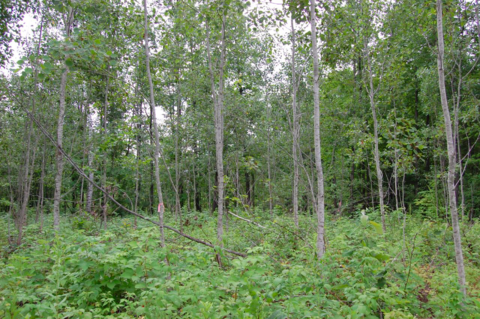When we were developing the climate-ready woodlands tree recommendation lists, we were often surprised about which tree species were not on these lists, including iconic Minnesota species such as quaking aspen (Populus tremuloides) or even the state tree, red pine (Pinus resinosa).
Although climate models don’t favor these species, that doesn’t mean they don’t hold intrinsic value, whether ecological, cultural or economic. These species contribute to complex ecological networks of plants, wildlife and fungi that provide diverse benefits.
We need to work to retain iconic species on our landscape, and we can do this by improving the diversity and resilience of our forest ecosystems. The best climate adaptation approach for our ecosystems implements practices from the entire spectrum of resistance, resilience and transition.
An example of a resistance-focused approach, where the goal is to retain the current state of your woodland, involves creating areas called refugia to protect species that are not predicted to perform well with climate change. Refugia are areas that remain buffered from climate change over time and can protect vulnerable species from the impacts of warming temperatures and more variable precipitation.
In the long term, climate refugia create key areas of biodiversity that are critical for maintaining ecosystem health and productivity.
Climate refugia in Minnesota
Luckily in Minnesota, Lake Superior allows us to create climate refugia for boreal species by buffering the climate along the North Shore. Lake Superior creates a significant cooling effect during the hot summer months that protects cold-adapted, boreal species such as eastern white pine (Pinus strobus) and paper birch (Betula papyrifera) as climate change causes summer temperatures to warm.
On a smaller scale, there are site conditions that can be ideal for climate refugia. For example, north-facing slopes are cooler and more moist than south-facing slopes that are exposed to hotter and drier conditions. Trees planted on north-facing slopes are less likely to be impacted by hot temperatures and drought, so those sites would be ideal for creating refugia for cold-adapted species such as white pine and paper birch.
Sites with wetter soils can also serve as refugia by being less impacted by drought, such as wetlands or soils with a higher percentage of clay. Landscapes modified by ecosystem engineers (like beavers) can even buffer forests from drought impacts by changing hydrologic dynamics through increased water retention.
Refugia can vary in size, ranging from small-scale microrefugia (such as a small northern white-cedar swamp) to landscape-scale macrorefugia (the complex boreal ecosystems along the North Shore of Lake Superior). Depending on the mechanisms that maintain the refugia, some may be more or less effective in the long term as the climate continues to change.
Consider creating refugia in your woodland
For woodland stewards looking to create refugia in your own woodlands, start by understanding your goals for your woodland, your personal connections with your woodland, and what you want your woodland to look like in the future.
We recommend working with a natural resource professional to identify potential sites for climate refugia and to implement practices to manage those refugia for long-term biodiversity and resilience.
Creating climate refugia is one of the approaches that we can take to help Minnesota’s forest ecosystems thrive in a future climate. When coupled with resilience and transition practices, we are helping to ensure that Minnesota’s forested landscape is as resilient and healthy as possible for future woodland stewards.
Hillman, A., & Nielsen, S. E. (2023). Lake Superior’s summer cooling of shorelines and adjacent inland forests: Implications for refugia of boreal forests and disjunct arctic-alpine plants. Ecology and Evolution, 13(12), e10833. https://doi.org/10.1002/ece3.10833
Morelli, T. L., Barrows, C. W., Ramirez, A. R., Cartwright, J. M., Ackerly, D. D., Eaves, T. D., Ebersole, J. L., Krawchuk, M. A., Letcher, B. H., Mahalovich, M. F., Meigs, G. W., Michalak, J. L., Millar, C. I., Quiñones, R. M., Stralberg, D., & Thorne, J. H. (2020). Climate-change refugia: Biodiversity in the slow lane. Frontiers in Ecology and the Environment, 18(5), 228–234. https://doi.org/10.1002/fee.2189
Morelli, T. L., Daly, C., Dobrowski, S. Z., Dulen, D. M., Ebersole, J. L., Jackson, S. T., Lundquist, J. D., Millar, C. I., Maher, S. P., Monahan, W. B., Nydick, K. R., Redmond, K. T., Sawyer, S. C., Stock, S., & Beissinger, S. R. (2016). Managing Climate Change Refugia for Climate Adaptation. PLOS ONE, 11(8), e0159909. https://doi.org/10.1371/journal.pone.0159909
Stralberg, D., Arseneault, D., Baltzer, J. L., Barber, Q. E., Bayne, E. M., Boulanger, Y., Brown, C. D., Cooke, H. A., Devito, K., Edwards, J., Estevo, C. A., Flynn, N., Frelich, L. E., Hogg, E. H., Johnston, M., Logan, T., Matsuoka, S. M., Moore, P., Morelli, T. L., … Whitman, E. (2020). Climate-change refugia in boreal North America: What, where, and for how long? Frontiers in Ecology and the Environment, 18(5), 261–270. https://doi.org/10.1002/fee.2188
Permission is granted to news media to republish our news articles with credit to University of Minnesota Extension. Images also may be republished; please check for specific photographer credits or limited use restrictions in the photo title.


